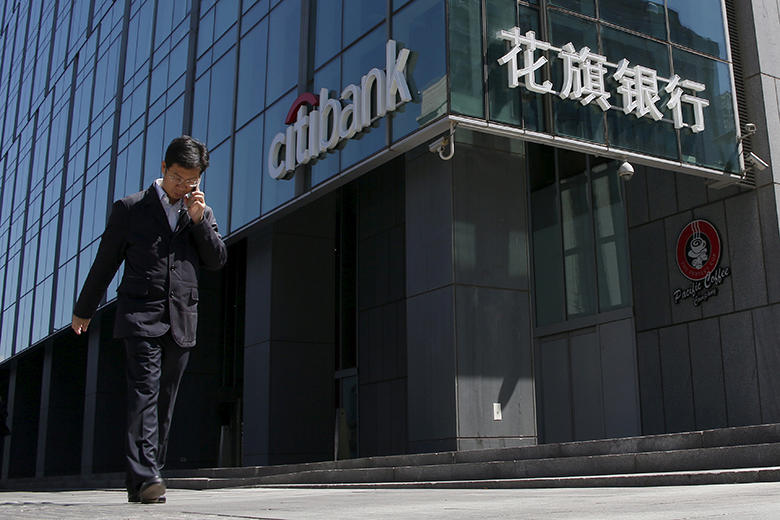Peter Babej was in the Greenwich Street offices of Citigroup chief executive Michael Corbat in lower Manhattan last summer when he learned the news. After nine years at the US lender, Babej would step up to be chief executive of Citi Asia Pacific.
He had always been a financial institutions group (FIG) guy: first at Lazard and then at Deutsche Bank. At Citi, he had spent the last three years running the bank’s global financial institutions team. Now here he was, the holder of one of the most important jobs at the US’s third largest bank by market capitalization and by far the most outward facing.
Asia is no normal region for Citi. It accounted for 21% of global revenues in 2019 (beaten only by its business in North America) and 27% of net income. It is highly digitally innovative region, crammed with ambitious multinationals and bursting both with people at the sharp end of the wealth spectrum and with those keen to get there.
It’s a region Citi mostly gets right – and it is keen to make sure it stays that way.
Babej knows how much responsibility has been placed in his hands. “Getting Asia right is critical for our organization,” he tells Euromoney on a stormy day in Hong Kong. “I was a big believer of that when I was the global head of financial institutions and I am even more so now.”
You are never going to un-ring the bell on Covid
Peter Babej
Babej doesn’t shy away from direct questions about his promotion, which came as a surprise to some in Asia. “Running a group of 350 people and running a business of over 60,000 is not the same thing,” he admits.
Citi thinks hard before decisions like these, so it’s worth asking why it placed such a broad role with huge systemic value in the hands of someone with a successful but relatively narrow CV.
A few reasons stand out. The first is the man himself. Born in the Czech Republic and raised in Germany, Babej comes across as an old-style humble and hardworking merchant banker, an adaptable team player who knows his own mind.
He is intense – as you’d expect from someone who resembles the actor Jürgen Prochnow in ‘Beverly Hills Cop II’ – but does not try to knock the other party off balance. And he disarms by listening to questions and then actually answering them in long sentences that emerge fully formed.
Another is his ability to commit to difficult decisions at a time of deep economic and financial distress. Babej was named Asia chief executive in October 2019. Within three months, coronavirus had emerged from China, spread across east Asia and was on its way to becoming a global pandemic.
It would have been easy to panic. Citi’s Asia business is enormously complex. Unlike north America, it sprawls, spanning 16 markets from Australia to Japan, none of which accounts for more than 16% of regional revenues.
| Total outstanding lending by market, Citi * ** |
||
| Market |
Total outstanding loans, ($ billions)** |
Oustanding loans as a share of global total (%)** |
| United Kingdom | 109.7 | 6.2 |
| Mexico | 59.1 | 3.4 |
| Hong Kong | 49.1 | 2.8 |
| Singapore | 46.8 | 2.7 |
| Ireland | 42 | 2.4 |
| South Korea | 32.7 | 1.9 |
| India | 28.5 | 1.6 |
| Brazil | 25.4 | 1.4 |
| Germany | 24.6 | 1.4 |
| Australia | 20.2 | 1.2 |
| China | 19.2 | 1.1 |
| Japan | 18.5 | 1.1 |
| *Excluding the US | ||
| **Data correct to end-June 2020 |
||
| Source: Citi | ||
Ten of those markets generated over $500 million in revenues in 2019; six breached the $1 billion mark. Asia comprises five of Citi’s 10 largest loan markets (excluding the US), led by Hong Kong, with 2.8% of outstanding global lending at the end of June 2020 and Singapore with 2.7%. In India 14,000 people work at its data centres, keeping multinationals ticking along, ensuring customers get orders and that staff are paid.
But Babej doesn’t seem the type to get agitated easily. Supported by a large team, many of whom remember the Sars pandemic of 2003, Citi reacted swiftly, telling 75% of staff in the early days of the new pandemic to work from home and handing a one-off payment to 25,000 personnel.
Babej publicly describes Covid as “very tragic”, adding that it is “tough to talk about it as an opportunity”.
Privately however, he and his team will have seen the pandemic as a chance for Citi to shine. Even before the disease crossed continents, it was set to be a defining moment for the bank and its customers. “Covid is the type of event that will be with us for a while and has already been through a number of cycles,” he says.

Tackling false truths
This meant learning lessons on the fly and tackling false truths. One was the mistaken belief that most firms wanted their bankers to descend on them every few weeks, to clutter up meeting rooms and then pick up the dinner tab.
Not so. “We had a view like every bank, that clients want you to be there in person and therefore that we should be travelling non-stop on the institutional side of the business in order to see as many [of them] as possible,” he says.
“That assumption turned out to be wrong. Clients are willing to switch to more modern ways of communication, even very old-school clients, which is different from what we expected. There are any number of CEOs who are very happy to have a video coffee or beer with you and discuss what is on their mind.”
So more Zoom and fewer air miles. This afforded Citi the opportunity to crowd as many business heads on to a single call as possible.
“What we have been doing, which is different from other banks, is to have the heads of our major businesses call clients together,” he says. “Throughout Covid, we have taken this approach with dozens of client CEOs and CFOs, helping to understand what is most concerning from their point of view, and in turn sharing our broad-based insights on the ground in Asia.”
That changes how Citi interacts with clients. Babej says the focus has shifted away from presenting one’s “best ideas” to a chief executive on a monthly basis, in favour of being “in touch with them daily, weekly, whatever it takes, to ensure you know how their problems are changing and what we can do for them”.
In Asia, you need someone in charge who is fully aware of what competitors, including technology firms, are up to
Senior Asia banker
Of course, most financial institutions have spent the past six months communicating with clients with unusual intensity. But there is a wider point to make here.
When Babej says Citi can “see things from an operational perspective that would not be visible to some of the pure-play investment banks,” he is directing attention to one of his bank’s most valuable resources.
Citi pools, sifts and analyses a vast amount of data, most of it collected using its global digital platform. In Asia, it offers everything from private banking and cash management, to credit cards and investment banking, across multiples markets, sectors and demographics. The data it hoovers up makes sense of complex events as they unfold and helps to predict (though never perfectly) outcomes.
In this sense, it acts like a lens, helping bankers, traders and relationship managers to make good decisions based on an abundance of reliable and well-analyzed data.
This is why Babej describes the way the bank supports its clients – especially at a time of a rolling crisis like this – as “a lot broader than institutional financial support” – although it’s worth adding that Citi’s regional investment bank had a stellar 2019 and carried that momentum into the new decade.
Quantity and quality
When Asia’s capital markets stirred into life in March 2020 after weeks of localized lockdown, Citi sprang out of the traps. It led a $500 million Covid-response bond for Korea’s Kookmin Bank and a 50-year sovereign print for the Republic of Indonesia. It helped firms to strengthen balance sheets, unveiled 90 client relief programmes in 17 markets and found time for creativity, courtesy of the complex equity collar it structured for Chinese property group Longfor in April.
An ability to mix quantity with innovative quality is a key reason Euromoney named it Asia’s best investment bank in 2020.
So, what does the future hold for Citi’s regional chief executive? While his elevation came as a surprise to some, the longer you analyze the decision, the more sense it makes.
Historically, Babej doesn’t quite fit the mould. His predecessor Francisco Aristeguieta was head of Citi in Latin America and Mexico, before being named Asia chief in 2015. Before him was Stephen Bird, another Citi stalwart and a former head of Asia consumer banking. The first flew in from Miami after his promotion; the second took the elevator up a floor or two.
By contrast, Babej’s route to the top in Asia was oblique. But perhaps his standout attribute is one that in another era would probably have counted against him. A global head of FIG asked to oversee 68,000 people in a sprawling region of central importance to his firm’s financial future doesn’t seem like an obvious fit.
But these are not normal times and assumed logic is no longer always enough.
Nowhere is the furious pace of innovation, particularly in financial services, more tangible than in Asia, where Chinese non-bank payments giants fight over market share, new customers and juicy data with rivals from Singapore, Indonesia and India.
FIG these days “is where many of the relationships lie,” notes a senior Asia banker. “It’s where innovations in technology are coming through and where the big threat [to banks] will come from. In Asia, you need someone in charge who is fully aware of what competitors, including technology firms, are up to.”
So, when Babej insists his old role is “very relevant to what is happening now,” it is a statement with real foundation.
Three challenges
The three challenges he chose to focus on from day one were digital, transaction banking and wealth management.
At the end of March 2020, Citi in Asia had 8.33 million digitally-active customers across 16 markets, or 53% of its client base. It is on track to welcome one million new mobile customers in 2020, matching last year’s performance.
Over 60% of all regional card payments are made via Alipay, while 70% of its mainland China customers are registered on WeChat – testimony to the strength of its partnerships with regional e-commerce giants such as Grab, Paytm and Lazada.
Covid has further accelerated digital adoption across its value chain. Citi added 355,000 new mobile clients in Asia in the first four months of 2020. Digital brokerage transactions jumped 78% year on year in the first quarter of 2020, with digital mutual funds transactions up 77% and forex transactions up 32%.
“Digital leadership was a huge focus for us before Covid and it is even more of a focus now,” says Babej. “It cuts across everything we do. If you are switched on as a digital player, you’re not only delivering the best button on an app but also driving the best customer experience, including efficient processing and data protection.”
Citi reckons the income it generated from digital clients in the five years to the end of 2019 was 38% higher than the corresponding number for traditional customers. Unlike Singapore’s DBS, it does not break down data to show its digital rate of return on tangible shareholders’ equity, although a spokesman says it is working on it.
If there’s one lesson to be learned from the Covid pandemic, it is that our economic and physical health and resilience, our environment and our social stability are inextricably linked
Peter Babej
The second challenge, transaction banking, is set to be a big beneficiary and driver of change this decade. Digital innovation originally started with consumer banking, followed by the rollout of online services to corporates.
The next step is to link everyone with everything. It’s why Babej highlights the need to invest in technology that generates efficiencies and integration in areas like treasury and trade solutions. “A lot of our retail customers in each market are also customers of our institutional clients,” he says.
Citi has spent a lot of money accelerating the process of digital on-boarding in 10 Asian markets and it is working to ensure its cross-border payments network can plug seamlessly into any given domestic payment platform.
Expect this process to continue as Asia’s big digital payments and e-commerce firms – many of them customers of Citi – become pan-regional players. Covid has accelerated this process: Citi reckons that since the pandemic emerged at the turn of the year, the bank has opened 1,000 new corporate digital accounts in Asia.
The final area of focus is personal wealth. At both ends of the spectrum, Citi’s private banking business is a moneymaking machine, overseeing $265 billion in regional assets under management at the end of 2019. But while it does a good job catering to high and ultra-high net-worth (UHNW) families and mass affluents, in the space in between it has, by its own admission, been missing a trick.
The bank aims to extend its Citigold Private Client (CPC) services to more Asian families with $1 million to $10 million in investable assets. A new position was created in the first week of August – head of Asia Pacific and EMEA CPC business – with San San Chan, a former Singapore-based retail head of wealth and segments, appointed to the role. A 17-year veteran of the bank, San San will be tasked with growing client assets in 11 markets and by at least 10% on an annual basis.
“Our wealth business is a phenomenal opportunity,” says Babej. “If we do our job right, we should be able to capture entrepreneurs relatively early in their progression when they still need financing support. There is still a significant gap between UHNWs and mass affluent, and it’s an opportunity we need to grasp. This is key in Asia, where a lot of the mega-wealth originates from entrepreneurship.
“As a financial intermediary this is a huge opportunity. It’s about serving new billionaires, who are being minted at twice the pace they are anywhere else, and about helping companies access capital markets for the very first time. As a bank with a presence in 16 regional markets, we can provide that like no one else,” he says.
Diversity
Going forward, there are a few other key things on his to-do list.
Diversity, particularly for big public-facing corporations, has never been more important, and those close to Babej say he has prioritized both the hiring of more women and the elevation of more females to positions of power. Citi wants at least 40% of all positions between associate vice president and managing director to be filled by women. It says it is currently at 39.5%.
In Asia, 30,000 members of staff, or 44% of the regional total, are female. Six of Citi’s 15-strong global executive management team are women and 23% of its Asian executive committee are female, up from 15% in 2017. Its two most senior China bankers are women: Christine Lam is China chief executive, with Angel Ng in charge in Hong Kong and Macau.
Two final issues loom large for Babej as he heads into year two. The first is China, the second is the world.
Barring any new crises, China will be the great personal and corporate capital-generation and capital markets story of the 2020s.
Citi is pumping resources into its onshore wealth management business and still hopes to secure, in the second half of 2020, the licences it needs to trade local securities, futures, foreign exchange and commodities. It exited its joint venture with Shanghai-based Orient Securities in the first half of 2020, and needs to get Beijing to approve its new raft of applications.
When Euromoney spoke to Babej’s predecessor, Aristeguieta, in 2018, he pointed to Citi’s China investment banking franchise as his biggest challenge. “We haven’t gotten China right sustainably for a long period of time,” he said.
| China ECM volumes by bookrunners, 2019 * ** | ||
| Name of bank | Deal value ($ million) | Number of deals |
| Goldman Sachs | 15,176 | 59 |
| Morgan Stanley | 13,102 | 68 |
| JPMorgan | 8,628 | 39 |
| Citi | 8,623 | 72 |
| Credit Suisse | 8,459 | 64 |
| UBS | 7,845 | 49 |
| BofA Securities | 6,481 | 33 |
| * Includes onshore and offshore ECM deals |
||
| ** Only includes non-China bookrunners |
||
| Source: Dealogic | ||
There are signs it has turned the corner. Citi has recruited where it was short on firepower. In November 2019, it hired Kara Wang and Dayday Zhou from HSBC in a bid to strengthen its real estate advisory business. It ranked fourth among foreign bookrunners in China ECM activity (onshore and offshore) in 2019.
The last 12 months saw Citi secure a role on several standout deals. It was a joint global coordinator on Alibaba’s $12.9 billion secondary listing, completed in Hong Kong in November 2019.
It also won a role on the initial public offering of Ant Group, an affiliate of Alibaba and owner of mobile payments platform Alipay. Ant wants to sell as much as $30 billion worth of shares in Hong Kong and on Shanghai’s Star Market by October, which would make it the world’s largest ever IPO. Citi will manage the Hong Kong leg of the sale, with JPMorgan, Morgan Stanley and China’s CICC.
Then there’s the world. The effects of Covid will drag on for years and many are probably baked in for good. As Babej succinctly puts it: “You are never going to un-ring the bell on Covid.”
So the world of work will change. To Citi’s Asia chief executive, this means being “even more nimble.” It means creating efficiencies and revisiting the nature and design of the workplace. And it means doing the right thing for people, clients and communities – even if such actions are “rarely the most convenient or the most economic”.
‘Inextricable link’
The pandemic has also forced everyone to consider afresh how we interact, not just with each other but with the world around us. In July, Citi unveiled a five-year sustainable progress strategy that will channel $250 billion into renewable energy, clean technology, conservation and sustainable agriculture projects.
“If there’s one lesson to be learned from the Covid pandemic, it is that our economic and physical health and resilience, our environment and our social stability are inextricably linked,” Babej said at the time.
This in turn means asking fundamental questions about the nature of trade. Global flows of people, goods, services and data defined the last 30 years of development. The ability of a pathogen to cross borders unhindered defined the last six months.
Some people want to reverse the course of globalization or slow it down. That seems unlikely. “It’s here to stay,” says Babej. “Banks use local data but pool it globally. Wealth managers cannot maintain scale without it.
“So not having a global lens is a non-starter,” he adds. “That kind of business with no global perspective and strategy does not exist anymore.”
But even as big banks become more global, they are being forced to rethink how they serve local communities. Babej talks of wanting to be a good “global and local [corporate] citizen”. In the first quarter of 2020, the bank gave 275,000 face masks to hospitals in Hong Kong and donated to Willing Hearts, a Singapore soup kitchen that delivers 6,500 meals a day, 365 days a year.
Financial protectionism continues to rise and from a regulatory point of view “things are getting more local and there is an increased need to satisfy local stakeholders.” He points to the famous quip – “It’s the economy, stupid” – coined by James Carville, then an adviser to US president Bill Clinton.
“That line is no longer as true as it was,” says Babej. “Now, it’s not just about the economy itself but about politics, about how society is changing, how expectations are changing in terms of what governments provide to borrowers. More than ever, advising our clients about what is going on in different parts of the world from a political, governmental and social perspective is a critical part of the equation. And no financial institution can do this better than us.”





